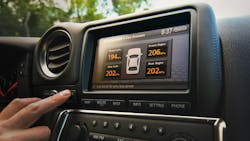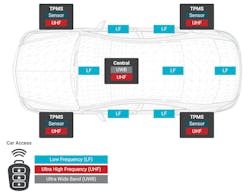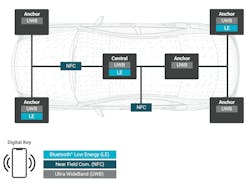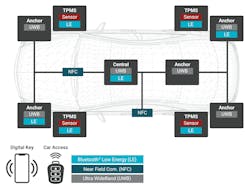Bluetooth Low Energy Reduces Automotive RF Device Power
What you’ll learn:
- Evolution of the vehicle RF architecture.
- Bluetooth Low Energy (LE) for physical key fobs.
- Bluetooth LE for tire pressure monitoring system (TPMS) applications.
Modern vehicles include an ever-increasing amount of radio-frequency (RF) technologies to meet customer expectations for performance and features. Meeting these demands only adds to overall design complexity, though, as well as creating challenges related to certification and homologation.
Such design challenges only increase when considering that the simultaneous operation of multiple radio technologies requires special interference precautions during development, along with extensive vehicle testing to ensure service availability and a high-quality user experience.
To overcome these hurdles, designers are turning to Bluetooth Low Energy (LE). It’s become more popular as a solution to reduce the amount of RF technologies in vehicles, and will likely expand to key fobs, tire pressure monitoring systems (TPMS), and digital key systems. Because Bluetooth LE software stacks provide specific optimized profiles, data rates, payloads, and roles, merging multiple systems with their individual communication requirements into a single system reduces overall complexity, lowers system costs, and simplifies homologation efforts.
Automotive Bluetooth LE devices enable multi-role configurations (peripheral, central) and can maintain a high amount of simultaneous connections to key fobs, TPMS sensors, and multiple mobile phones. Bluetooth LE devices also have very low current consumption—a single coin-cell battery can last as long as 10 years. Such low power consumption makes it easier to switch from a proprietary RF solution to the Bluetooth LE protocol.
In this article, we’ll explore the evolution of vehicle RF architectures, and how you can benefit from Bluetooth LE-based approaches for end equipment such as key fobs, TPMS, and digital keys.
Evolution of the Vehicle RF Architecture
Figure 1 shows a traditional RF vehicle architecture. Key fobs use short-distance bidirectional low-frequency communication for immobilizer operation to start the vehicle. For passive-entry/passive-start functionality, long-distance low-frequency communication wakes up the key fob, which transmits its response using UHF frequencies.
Some TPMS sensors use proprietary technologies, with short-range low-frequency communication for service mode to calibrate and configure the TPMS sensor, and UHF transmissions communicate with the vehicle central node about tire status. They provide information about tire pressure, temperature and the TPMS battery.
Figure 2 shows the RF architecture used to implement digital key systems, which leverage smartphone applications (encompassing a range of technologies) for car access to unlock/lock doors and start the engine if a mobile phone is detected inside the cabin. For example, smartphone integration allows users to access apps, place phone calls, send messages, use navigation, and stream music. Users can also access some of these options remotely and check the status of the vehicle in real-time.
Near-field communication (NFC) and Bluetooth LE enable communication between a smartphone and a vehicle, letting users lock and unlock the doors and start the engine. Ultra-wideband (UWB) technology enables location tracking to enhance security and usability by allowing the vehicle to detect the position of the user’s smartphone.
The digital key standards currently in place are designed to ensure interoperability and security between different car manufacturers and smartphones. The first release focused on support through NFC as a backup function, enabling basic access services if the user’s smartphone battery dies. Holding the smartphone close to the door handle unlock/locks the doors through the NFC interface, while placing the smartphone in the center console enables NFC communication to start the engine.
>>Check out this TechXchange for similar articles and videos
The high-end version of digital key integration uses Bluetooth LE for communication and UWB for localization to access the car without interacting with a smartphone, similar to a passive-entry/passive-start function, as shown in the Phone as a key (PaaK) reference design from Texas Instruments (slla679.pdf is attached below for readers’ easy reference). The smartphone only needs to be in range of the vehicle.
TCAN24xx devices in Phone-as-a-Key (PaaK) applications
As seen in Figure 2, a typical RF vehicle setup comprises two NFC readers, several Bluetooth LE nodes. and up to six UWB nodes. These standard radio technologies are mandatory to implement digital key functionality for smart devices. However, standard RF technologies differ from the proprietary RF technologies used in traditional car access architectures.
Bluetooth LE’s implementation in various automotive applications and integration into digital key systems will likely spur further innovations, enhancements, and system cost savings. The recently released Bluetooth LE 6 standard introduces channel-sounding ranging capabilities to significantly improve localization services, which will provide more accurate and reliable proximity sensing for keyless entry and ignition startup. Vehicles will be able to detect the presence of a Bluetooth LE-enabled device (such as a smartphone or key fob) with greater precision, ensuring smoother and more secure access.
In addition, Bluetooth LE can deliver over-the-air software updates, ensuring that the different nodes, key fobs, and TPMS sensors have the latest features and security patches without the need for drivers to visit a dealership. With full smartphone integration, Bluetooth LE facilitates enhanced vehicle health monitoring, opening the door to continuous monitoring of vehicle health and performance. This data can be transmitted to a smartphone app or directly to a service center for proactive maintenance and troubleshooting.
Given the benefits in the context of system cost pressures, demands to simplify vehicle architectures, short time-to-market requirements, and lower homologation efforts, many designers are considering a transition from proprietary RF technologies to standardize all systems on Bluetooth LE communication schemes.
Bluetooth LE for Physical Key Fobs
Transitioning from low-frequency and UHF technology to Bluetooth LE in key fobs will simplify vehicle architectures by eliminating low-frequency transceivers, antennas, cabling, connectors, and UHF receiver modules from the vehicle, freeing up space and reducing wire harness complexity. Because low-frequency antennas are often placed inside door handles, removing them could enable new door handle designs, which improves fuel consumption by optimizing the shape of the vehicle.
On the key fob itself, Bluetooth LE makes it possible to replace the low-frequency wake receiver, including large, heavy 3D antennas, and the UHF transmitter, significantly reducing key fob complexity. Channel sounding enables accurate and reliable proximity sensing for keyless entry and ignition start scenarios. And with bidirectional communication, higher security protocols can be implemented, preventing the replay attacks that occur when using unidirectional communication protocols.
Bluetooth LE technology in key fobs can streamline access control in fleet management and car-sharing services, allowing for the secure and flexible allocation of vehicles to different users. It will also provide valuable data for optimizing fleet operations and maintenance schedules by tracking vehicle usage and driver behavior.
Overall, Bluetooth LE-equipped key fobs are set to play a major role in the evolution of automotive applications, enhancing security, convenience, personalization and connectivity.
Bluetooth LE for TPMS Applications
In TPMS, Bluetooth LE brings advantages in power efficiency, connectivity, and data transmission. With their low power consumption, newer generations of Bluetooth LE devices are an ideal fit for TPMS sensors, since they need to operate for extended time periods powered only by small coin-cell batteries. Enhanced Bluetooth LE technology will lead to even longer battery lifetimes.
Data rates for Bluetooth LE communication are 100X faster than legacy solutions. Thus, the implementation of real-time monitoring is now possible, and would enable more frequent and accurate real-time data transmission from TPMS sensors to the vehicle’s central system.
Drivers could receive up-to-date tire pressure information (such as tire temperature, sensor health, and potential air leaks), tire tread information, or even information about road conditions. This enables more advanced diagnostics (because of the transmission of additional diagnostic data) and more comprehensive monitoring and proactive maintenance by creating the ability to analyze data trends over time.
Bluetooth LE electronic control units (ECUs), which are already available for digital key systems, can also handle key fob and TPMS connections, simplifying vehicle architecture and complexity. Infotainment systems, driver assistance systems and mobile apps can easily access TPMS status information through a centralized hub containing all vehicle health information.
Direct Bluetooth LE connections between mobile devices and TPMS sensors are feasible. It allows for easy direct configuration, diagnostic functionality, and alerts, even when drivers are not in the car.
The transition toward Bluetooth LE-based TPMS solutions will lead to stronger encryption, authentication, and anti-counterfeit and fraud protection methods, ensuring that data transmitted from TPMS sensors to the vehicle’s central system is secure and protected from tampering or hacking. This is especially relevant for autonomous vehicles.
Streamlining the pairing process between TPMS sensors and the vehicle’s central system reduces setup times and user intervention. It ultimately eliminates the need to provide custom tools at service points, since communication is possible with any modern smartphone.
As Bluetooth LE continues to evolve, more advanced, reliable, and cost-effective TPMS solutions will contribute to safer and more efficient driving experiences.
Next-Generation Vehicle Architectures with Bluetooth LE
A modern vehicle architecture will merge digital key systems, key fobs, and TPMS (Fig. 3), using standard RF technologies to significantly reduce system cost and complexity. Bluetooth LE plays a central role in this trend by offering the highest protocol flexibility and ease of adoption. Optimization for low power consumption, long battery lifetimes, and low system cost is feasible, as is reducing manufacturing costs and a shorter time-to-market.
Please subscribe to Andy’s Automotive Electronics bi-weekly newsletter.
>>Check out this TechXchange for similar articles and videos
About the Author

Jürgen Austen
Marketing Manager for Automotive Connectivity Solutions, Texas Instruments
Jürgen Austen is the marketing manager for automotive connectivity solutions. He has more than 20 years of experience in marketing, systems, and applications for embedded processing targeting the automotive wireless market. He specializes in digital key, car access, and key fob solutions as well as tire pressure monitoring and wireless battery-management systems.

Marcus Frech
Digital Field Application Engineer, Texas Instruments
Marcus Frech is a digital field application engineer, responsible for major German car OEMs. He has more than 20 years of sales and marketing experience in industrial and automotive markets. His current focus is on automotive ADAS, infotainment, telematics, networking and body applications, including car access.




